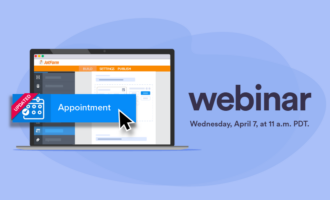An automated webinar is another name for a “prerecorded webinar.” This means that it isn’t live when people watch it.
There are advantages to producing an automated webinar. For instance, you can edit an automated webinar before releasing it, whereas a live webinar can’t be edited in the moment. Automated webinars can also be less work — instead of having a speaker spend hours filming live webinars, they can instead record an automated webinar once and use it repeatedly.
Perhaps the biggest advantage is that automated webinars can be used over and over. They become lasting resources that are associated with your brand. In this sense, automated webinars are a great way to deliver “evergreen” content — content that doesn’t become dated quickly. Evergreen webinars are still valuable and worth watching in a year, two years, or maybe even a decade.
How to create an automated webinar
There are plenty of webinar tools that are specifically designed for automated webinar recording. For instance, EverWebinar is a popular option for creating prerecorded content. Choose a webinar recorder that’s specifically designed for automated webinars if possible, then learn the ins and outs of this webinar software so that you can record with confidence.
While crafting the content for an automated webinar, keep in mind that this content should have lasting relevance. While a live webinar can discuss a recent development in the industry, an automated webinar should touch on topics that will be as relevant in a year as they are today.
Tips for thinking of effective evergreen content
So how do you go about picking evergreen topics? Put yourself in your clients’ shoes. For instance, if you’re running a business that sells a particular product, creating a webinar with an in-depth product demonstration will probably be relevant to your customers for the duration of your business’s existence.
Basic, foundational concepts are always evergreen. For instance, if Jotform were creating an evergreen webinar, we’d probably want to focus on the core capabilities of our online forms — things that will never be irrelevant to our product and that customers will want to learn about for years to come.
Avoid highly specific references in evergreen content. As you create your evergreen content, keep in mind the things that might make your video sound dated. Avoid focusing on specific technology that may be obsolete in a few years unless absolutely necessary. And if you’re discussing recent industry news, keep in mind that such references may feel irrelevant to viewers in the future.
You’ve made your automated webinar…now what?
Once you’ve created evergreen content, it’s time to figure out what to do with it. You have plenty of options. Here are a few that have paid off for businesses in the past:
- Course format. Software like EverWebinar helps you easily organize your automated webinars into a series that resembles an online course. For example, if you produce a series of webinars about the basic ways businesses can benefit from using your product, you might want to group these videos together and maybe even sequence them so that each video builds on the previous one. This can turn your webinars into a powerful, comprehensive resource.
- Add them to your website. Webinars can serve as a powerful part of the sales funnel, educating consumers about your product or service in an engaging, entertaining way. That’s why displaying these webinars prominently on your website, as well as in your social feeds, can be a great way to supplement your existing marketing materials.
- Drive revenue with webinars. Webinars contain valuable information, so it’s reasonable to place them behind a paywall. For evergreen content, this can be a particularly profitable decision, as people will continue to purchase your webinars over the course of an extended period.
Webinars are incredibly versatile media. While live broadcasts offer specific benefits, there’s a lot to be gained from creating evergreen webinars that entertain and inform for years to come. Which evergreen topic will you tackle in your next webinar?













Send Comment: